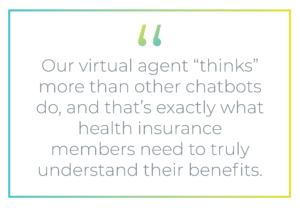In many industries, every time we land on a website, there’s a tiny chatbot in the lower right corner that asks, “Can I help you with something?”
Technology-enabled customer service tools can be helpful for engaging with members – but only when they’re designed to provide a fully satisfying service experience for the user.
Many people in the tech world use the terms “chatbot,” “virtual agent,” and “conversational AI” interchangeably to describe these common customer service experiences, and there are no formal definitions that describe the exact parameters, tasks, and language of either one.
Chatbots with hard-coded decision trees that force the user down an unintuitive path and expect limited, predefined responses are getting an increasingly bad reputation. Many of them are so limited that they actually become annoying rather than helpful for users, especially in the complex world of healthcare.
The New York Times shares, “Our interactions with the technology will become increasingly personalized. Chatbots, for example, can be clumsy and frustrating today, but they will eventually become truly conversational, learning our habits and personalities.”
The Sensentia Agent is a sophisticated conversational member self-service solution that goes beyond typical pre-programmed chatbots to help you provide exceptional service for your members. Most importantly, it resolves members’ individual problems not in a one-size-fits all but individual manner. This is particularly crucial in the domains of plan comparison, pharmacy, and deep benefit decision support – including limits, exclusions, inclusions, pre-authorization requests, and fine-print in the member’s individual health policy.
Sensentia starts with fundamental AI modeling of unstructured data directly from the member’s health plan to power the most sophisticated and accurate conversational AI member service experience. Only by using this foundational source of truth can a virtual agent truly answer an individual’s questions and help them decide and solve problems.
The Downside of Chatbots for Healthcare Customer Service
Chatbots are often perceived to be:
Limited for individual member problem solving. Many chatbot solutions do not go further than providing general answers that suit every user, such as “How can I get a new ID?” They are similar to conversational FAQ systems. Individual problems such as “What are my benefits for a skilled nursing facility stay after knee surgery?” are far from being supported.

Less flexible. In many organizations, chatbots are often thought of as “one task” tools. Once you have a chatbot that does one thing – like answering benefit cost inquiries – that is the bot’s only job and it will never go beyond that.
Less “intelligent”. With most chatbots, your members have to enter the perfect string of keywords to get an answer. For example, someone would need to enter questions like, “What is my copay and coinsurance for my primary care physician?” versus something simpler like “How much is a pcp visit?”.
Limited in use. Many simple bots, like the ones used by Facebook or Slack, have around 8 to 15 intents they can understand. Usually they understand those intents poorly because they are programmed rather than intelligent.
Only available on a single channel. The logic underlying a chatbot doesn’t have to be limited to a text GUI on a web browser – it can be put on nearly anything, including mobile apps, Alexa, etc..
Limited in analytics. Most premade bots have very few analytics, and quite a few have none at all. Simple chatbots might remember simple data like inputs, outputs, timestamps, and/or intent recognized – or they may not.
Sensentia Agent: Why Our Conversational AI Solution Is Smarter Than the Average Chatbot
Conversational AI is usable across your entire organization, with full flexibility to do anything you need. Sensentia Agent is designed to be used across different parts of an organization, website, or platform, using data and context from all areas. You can model it once and deploy it anywhere, across multiple channels and functions (like sales and service).
For example, pharmacy transfer can be used across multiple channels and platforms. No matter what channel your members use, the virtual agent interface can retrieve drug pricing from your plan’s source of truth documents or AI data models, to give consistent information they can count on. Instead of just spitting out rote answers to a short list of pre-programmed questions, virtual agents can provide truly useful, customized information across a broad range of topics.
Conversational AI is smarter and better at natural language processing, so it can enhance the customer service experience in meaningful, human-like ways. It has richer conversational capabilities and can understand natural language, synonyms, and even complex healthcare acronyms.
For example, Sensentia Agent is trained to interpret the term “cheapest plan” to mean your member is interested in premiums, but when someone asks “how much is <requested service>” it will return both the copay and coinsurance for that service, according to Sensentia’s foundational benefit data modeling.

Conversational AI can be multi-channel, and multi-language. You can hold the same conversations with your members on multiple channels, including voice, text, mobile app, Alexa, and more. Anywhere you want to put your conversational agent functionality, we can make it work for you, and your members can have a consistent experience everywhere they go.
Want to add another language? With Sensentia Agent, adding additional languages is a considerably smaller investment of time and money over pre-programmed chatbots, because most of the logic can be reused.
Conversational AI provides richer analytics. Sensentia Agent will not only save sessions and queries, but it can store and analyze data about member interactions, distilling actionable intelligence. This creates a seamless member experience, especially when transitioning from the virtual agent to a live agent.
Your conversational agent can be more than just a tool to deflect calls and give members another communication channel – it also becomes an important source of information for your call center about what your members really need. Analytics like this can help you continually improve member engagement.
Sensentia Agent is backed by powerful artificial intelligence. Sensentia’s back-end engine, and Artificial Solutions’ conversational AI technology, enable online chat conversations in lieu of interaction with a live agent, returning rich, detailed responses from complex data with near-perfect accuracy. In other words, our virtual agent “thinks” more than other chatbots do, and that’s exactly what health insurance members need to truly understand their benefits.
Shifting the Consumer Healthcare Experience
Flat, pre-programmed chatbots that can only regurgitate static answers to a few basic questions might pass muster in other industries, but they’re not enough for most health insurance plans.
Healthcare requires more sophisticated virtual support than other types of businesses. To provide an online conversational interface that does more than just annoy your members, you need a powerful virtual agent backed by Sensentia’s best-in-class artificial intelligence engine.
Sensentia Agent Powers Sales and Service
Sensentia’s conversational AI agent solution enables prospects, members and providers alike to deeply understand benefits at the highest level of detail, including limits, inclusions, exclusions, conditions, pre-authorization and referral requests. Our virtual agent is the smartest choice for all health plan users.


- Starts with Foundational Benefits Modeling from the Member’s Health Policy
- Retains Conversation Context for Intent and Service Recognition
- Transfers Conversation from Virtual to Live Agent for Continuity
- Prompts Users for Quick, Easy Responses
- Understands Multiple Languages
- Handles Topic Changes and Interruptions Flawlessly
- Offers User Input Options including Buttons, Clickable Prompts, Text, and ASR
- Populates Dynamically and Updates in Real Time
- Supports Flexible Integrations
To schedule a demonstration of the Sensentia Agent, click HERE or explore Sensentia.com to learn more.


